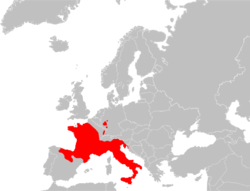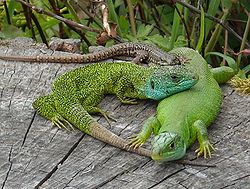- Lacerta bilineata
-
 Lézard vert occidental
Lézard vert occidentalMâle et femelle
(accompagnés d'un lézard des murailles)Classification Règne Animalia Embranchement Chordata Classe Reptilia Ordre Squamata Famille Lacertidae Genre Lacerta Nom binominal Lacerta bilineata
(Daudin, 1802)Statut de conservation UICN :
Répartition géographique 
/ Lacerta bilineata
 Retrouvez ce taxon sur Wikispecies
Retrouvez ce taxon sur Wikispecies
D'autres documents multimédia
sont disponibles sur CommonsLe lézard vert occidental, aussi appelé lézard à deux bandes (Lacerta bilineata) est une espèce de lézards de la famille des lacertidés que l'on rencontre principalement en Europe, de la France à la Croatie, ainsi qu'aux États-Unis où il a été introduit au Kansas.
Sommaire
Description
Tout comme son proche cousin Lacerta viridis, Lacerta bilineata a une teinte de fond verte mouchetée de noir. On peut également y voir des teintes de bleu sur la gorge, notamment chez le mâle adulte, même si cette coloration peut être aussi présente chez la femelle.
Les individus subadultes présentent deux bandes blanches bien marquées sur le dos et la queue, ce qui vaut à l'espèce son nom vernaculaire : lézard à deux bandes. Cette spécificité permet de la distinguer de Lacerta viridis.
Répartition
Cette espèce de reptile se rencontre dans de nombreux pays d'Europe : France, Suisse, Espagne, Monaco, Italie, Croatie, allemagne, Royaume-Uni, ainsi qu'aux États-Unis où il a été introduit.
Taxinomie
Classification
Cette espèce a longtemps été nommée Lacerta viridis bilineata, considérée comme une sous-espèce de Lacerta viridis (Engelmann et al., 1993). La classification a été modifiée par la suite par Amann et al., 1997 puis Bischoff, 2005, pour devenir la classification actuelle qui considère Lacerta bilineata comme une espèce à part entière.
Sous-espèces
- Lacerta bilineata bilineata Daudin, 1802
- Lacerta bilineata chloronota Rafinesque-Schmaltz, 1810
- Lacerta bilineata chlorosecunda
- Lacerta bilineata indet (Elbing, 2001)
- Lacerta bilineata fejervaryi Vasvary, 1926
Voir aussi
Références
- Amann, Toni;Rykena, Silke;Joger, Ulrich;Nettmann, Hans Konrad;Veith, Michael 1997. Zur artlichen Trennung von Lacerta bilineata Daudin, 1802 und L. viridis (Laurenti, 1768). Salamandra 33 (4): 255-268
- Bischoff, W. 2005. Die echten Eidechsen der Familie Lacertidae - eine Übersicht. Draco 5 (21): 4-27
- BOGAERTS, S. 2000. Beobachtungen einer Paarung zwischen zwei Weibchen von Lacerta bilineata DAUDIN, 1802. Die Eidechse 11 (2): 63-64
- Böhme, M.U.; Fritz, U.; Kotenko, T.; Dzukic, G.; Ljubisavljevic, K.; Tzankov, N. & Berendonk, T.U. 2007. Phylogeography and cryptic variation within the Lacerta viridis complex (Lacertidae, Reptilia). Zoologica Scripta 36 (2): 119–131
- Bruner, Emiliano; Costantini, David; Fanfani, Alberto; Dell'Omo, Gaicomo 2005. Morphological variation and sexual dimorphism of the cephalic scales in Lacerta bilineata. Acta Zoologica 86: 245-254.
- Daudin, F. M. 1802. Histoire Naturelle, générale et particulièredes reptiles, ouvrage faisant suite, a l'histoiure naturelle, générale et particulière composée par LECLERC DE BUFFON, et redigée par C. S. SONNINI, vol. 3. F. Dufart, Paris.
- DIECKMANN, M. 2001. Vermehrung von Lacerta bilineata bilineata im Freilandterrarium Die Eidechse 12 (3): 80-83
- ELBING, K. 2001. Die Smaragdeidechsen - zwei ungleiche Schwestern. Z. Feldherpetol. (Beiheft) 3 (Laurenti-Verlag, Bochum).
- Engelmann,W.E. et al. 1993. Lurche und Kriechtiere Europas. Neumann Verlag (Radebeul, Germany), 440 pp.
- FUNKE, O. 1996. Ungewöhnliches Verhalten von Lacerta bilineata und Podarcis muralis. Die Eidechse 7 (18): 30
- Grano, M. & Grano, P. 2006. Surrounded by water - reptiles of the Tuscan archipelago. Reptilia (GB) (47): 64-69
- Gubanyi, James 2000. A breeding colony of western Green Lacertas (Lacerta bilineata) confirmed in southwestern Topeka (Kansas). Transactions of the Kansas Academy of Science 103 (3-4): 191-192
- Henf, M. & Alfermann, D. 2004. Neunachweis der Smaragdeidechse im hessischen Lahntal. Salamandra 40 (3/4): 235-238
- Lantermann, W. & Lantermann, Y. 2007. Westliche Smaragdeidechsen (Lacerta bilineata) an der Atlantikküste in der Bretagne. Reptilia (Münster) 12 (2): 40-42
- Meyer, S. 2005. Der Smaragdeidechsenwald von Caorle. Reptilia 10 (2): 41-49
- Nettmann, H. K. 1995. Zur Geschichte einer vermeintlichen Neuentdeckung Elaphe 3 (4): 63-66
- Rohdich, W. 2005. Die Grünen vom Kaiserstuhl. Draco 5 (21): 68-71
- Rykena, S. 1991. Kreuzungsexperimente zur Pru?fung der Artgrenzen im Genus Lacerta sensu stricto. Mitteilungen des Zoologischen Museum Berlin, 67, 55–68
Liens externes
- Référence Reptarium Reptile Database : Lacerta bilineata Daudin, 1802 (en)
- Référence Catalogue of Life : Lacerta bilineata DAUDIN 1802 (en)
- Référence Fauna Europaea : Lacerta bilineata (en)
- Référence ITIS : Lacerta bilineata Daudin, 1802 (fr) ( (en))
- Référence Animal Diversity Web : Lacerta bilineata (en)
- Référence NCBI : Lacerta bilineata (en)
Wikimedia Foundation. 2010.





